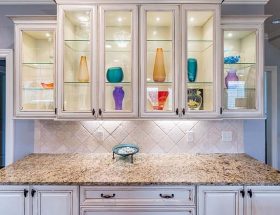The use of custom cut glass has become increasingly popular in various industries, ranging from architecture and interior design to automotive and industrial applications. Custom cut glass offers unique design possibilities and functional advantages, making it a versatile material for creative expression. In this article, we will explore the art and science of custom cut glass, delving into the techniques, materials, and design possibilities that unleash creativity in various settings.
Introduction
Custom cut glass refers to the process of cutting and shaping glass according to specific design requirements. This technique allows for precise customization of glass to fit various shapes, sizes, and styles, making it a favored choice for architectural elements, decorative features, and functional applications. Custom cut glass can be used in a wide range of settings, from residential and commercial spaces to automotive and industrial applications.
Importance of Custom Cut Glass
Custom cut glass plays a crucial role in enhancing aesthetics and functionality in different settings. The ability to customize glass allows for the creation of unique and eye-catching designs that can elevate the overall appearance of a space or product. Custom cut glass can be used to create stunning architectural features, such as glass facades, partitions, balustrades, and skylights, which add a touch of elegance and sophistication to buildings. In interior design, custom cut glass can be used for decorative purposes, such as glass shelves, tabletops, backsplashes, and mirrors, to create visual interest and focal points. Custom cut glass is also used in automotive and industrial applications, such as windshields, windows, displays, and equipment, to provide clarity, durability, and safety.
Understanding the Art of Custom Cut Glass
The art of custom cut glass involves a combination of techniques, skills, and creativity. Skilled artisans and craftsmen use various tools and equipment to cut, shape, and polish glass according to specific design requirements. Traditional techniques, such as hand-cutting, engraving, and etching, are often used to create intricate and detailed designs on glass surfaces. Modern techniques, such as waterjet cutting, laser cutting, and CNC machining, allow for precise and complex cuts, shapes, and patterns. The art of custom cut glass also involves the selection of glass types, colors, and textures, as well as the use of other materials, such as metal, wood, and plastic, to create unique combinations and effects.
The Science Behind Custom Cut Glass
The science behind custom cut glass involves the understanding of the materials and properties of glass. Glass is a solid material that is made by heating a mixture of silica (sand), soda (sodium carbonate), and lime (calcium oxide) to a high temperature until it melts and forms a transparent, rigid structure upon cooling. The composition and processing of glass can affect its properties, such as strength, transparency, color, and thermal conductivity.
The selection of the right type of glass for custom cut glass applications depends on the specific requirements of the project. Common types of glass used in custom cut glass include float glass, tempered glass, laminated glass, and stained glass. Float glass is the most common type of glass used in architectural applications due to its clarity and versatility. Tempered glass is treated with heat or chemicals to increase its strength and safety, making it suitable for applications that require impact resistance and safety, such as doors, windows, and partitions. Laminated glass is made by sandwiching a layer of plastic between two or more layers of glass, providing added safety and security features, and is commonly used in applications that require sound insulation or UV protection. Stained glass is a type of glass that is colored using metallic salts and is often used in decorative applications, such as windows, panels, and art pieces.
The properties of glass, such as its transparency, reflectivity, and thermal conductivity, can also be modified through various techniques, such as frosted glass, mirrored glass, and coated glass. Frosted glass is created by etching or sandblasting the surface of the glass to create a translucent or opaque appearance, providing privacy and diffusing light. Mirrored glass is coated with a reflective layer, typically made of silver or aluminum, which creates a mirror-like effect and is used in applications that require reflection, such as mirrors and decorative elements. Coated glass is treated with a thin layer of metallic or non-metallic material, such as Low-E (low emissivity) coating, which improves the thermal insulation properties of glass, making it energy-efficient and suitable for applications that require insulation, such as windows and doors.
Unleashing Creativity with Custom Cut Glass
Custom cut glass offers endless design possibilities, allowing for creativity and uniqueness in various settings. The ability to customize glass according to specific design requirements opens up opportunities for creating one-of-a-kind pieces that reflect personal style and taste. Custom cut glass can be used to create mesmerizing patterns, shapes, and textures that add visual interest and depth to architectural features, interior spaces, and products.
In architecture, custom cut glass can be used to create stunning facades, partitions, staircases, and balustrades that become focal points of a building’s design. Intricate patterns, etchings, and textures on glass surfaces can create a sense of elegance, luxury, and artistry. Custom cut glass can also be used to incorporate branding elements, logos, and signage into the design of commercial spaces, creating a unique and memorable impression on visitors and customers.
In interior design, custom cut glass can be used to create unique and functional elements, such as glass shelves, tabletops, backsplashes, and room dividers. The ability to customize glass allows for the creation of patterns, colors, and textures that complement the overall design theme of a space and create a cohesive look. Custom cut glass can also be used to create statement pieces, such as glass art installations, lighting fixtures, and furniture, that add a touch of sophistication and creativity to interior spaces.
Custom cut glass can also be used in automotive and industrial applications to create innovative and functional designs. In the automotive industry, custom cut glass can be used to create curved windshields, panoramic roofs, and unique window shapes that enhance the aesthetics and functionality of vehicles. In industrial applications, custom cut glass can be used for displays, control panels, and equipment, providing clarity, durability, and safety features.
Applications of Custom Cut Glass
The applications of custom cut glass are vast and varied, ranging from architecture and interior design to automotive and industrial sectors. Some common applications of custom cut glass include:
- Architectural glass: Custom cut glass can be used in architectural applications such as facades, partitions, balustrades, and staircases to create unique and visually stunning designs that enhance the aesthetic appeal of a building.
- Interior design: Custom cut glass can be used in interior design to create glass shelves, tabletops, backsplashes, room dividers, and other functional and decorative elements that add a touch of elegance and creativity to interior spaces.
- Automotive industry: Custom cut glass can be used in the automotive industry to create curved windshields, panoramic roofs, and unique window shapes that enhance the aesthetics and functionality of vehicles.
- Industrial applications: Custom cut glass can be used in industrial applications for displays, control panels, and equipment, providing clarity, durability, and safety features.
- Art and decor: Custom cut glass can be used to create glass art installations, lighting fixtures, and furniture that add a touch of sophistication and creativity to any space.
- Hospitality and retail: Custom cut glass can be used in hospitality and retail settings for storefronts, display cases, and signage, creating a unique and memorable impression on customers.
- Kitchen and bath: Custom cut glass can be used in kitchen and bath applications for backsplashes, countertops, shower enclosures, and mirrors, adding a modern and luxurious touch to these spaces.
- Furniture and cabinetry: Custom cut glass can be used in furniture and cabinetry to create glass doors, shelves, and panels that add a sleek and contemporary look to the overall design.
- Greenhouses and conservatories: Custom cut glass can be used in greenhouses and conservatories to create large panels of glass that provide natural light and create a conducive environment for plant growth.
- Display cases and museum exhibits: Custom cut glass can be used in display cases and museum exhibits to protect and showcase valuable artifacts, artworks, and specimens, while adding a touch of elegance and sophistication.
Conclusion
Custom cut glass is a versatile and creative material that allows for endless design possibilities in various applications, from architecture and interior design to automotive and industrial sectors. Its ability to be customized according to specific design requirements unleashes creativity and enables the creation of unique and visually stunning pieces. Whether it’s for architectural facades, interior design elements, automotive windshields, or art installations, custom cut glass adds a touch of elegance, sophistication, and creativity to any space or product.









